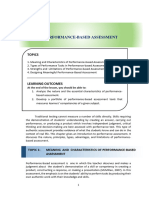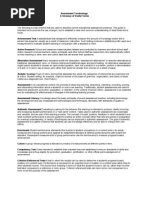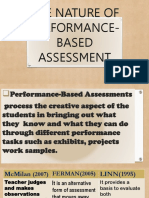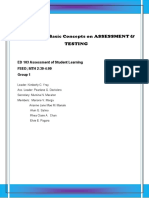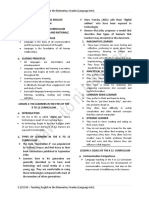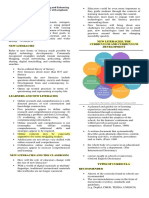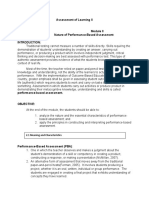Lesson 3 Different Classifications of Assessment
Uploaded by
Hot DoughnutLesson 3 Different Classifications of Assessment
Uploaded by
Hot DoughnutlOMoARcPSD|31879758
Lesson 3 Different Classifications of Assessment
BS Education (Colegio de Sta. Ana de Victorias)
Scan to open on Studocu
Studocu is not sponsored or endorsed by any college or university
Downloaded by Shalom Schwartz (ceriloskc@gmail.com)
lOMoARcPSD|31879758
COLEGIO DE STA. ANA DE VICTORIAS, INC.
Osmeña Ave., Victorias City, Negros Occidental
Email: colegiodestaanadevictorias@yahoo.com
Telefax No. (034) 399-2830
MODULE 1: AN INTRODUCTION TO ASSESSMENT IN LEARNING
LESSON 3: Different Classifications of Assessment
LEARNING OUTCOMES
At the end of the lesson the student should be able to:
Illustrate scenarios in the use of different classifications of assessment
Rationalize the purpose of different forms of assessment
Decide on the kind of assessment to be used.
PERFORMANCE TASK AND SUCCESS INDICATORS
At the end of the lesson, you should be able to demonstrate your knowledge and skills in
illustrating and selecting the appropriate kind of assessment.
Contents of the Illustrative Success Indicators
Scenario
Rationalized the kind of assessment all the possible justifications to help the teacher identify
used student learning and how learners will benefit from the
information are provided.
provided the procedure on how to all necessary procedures that are appropriate in
conduct the assessment conducting the assessment are described.
provided the purpose of the all the possible purposes of conducting the
assessment assessment are clearly indicated.
What are the different classifications of assessment?
The different forms of assessment are classified according to purpose, form, interpretation of
learning, function, ability and kind of learning.
Classification Type
Purpose Educational
Psychological
Form Paper-and-Pencil
Performance-based
Function Teacher-made
Standardized
Kind of Learning Achievement
Aptitude
Ability Speed
Power
Interpretation of Learning Norm-referenced
Criterion-referenced
1st Semester AY 2021-2022
Downloaded by Shalom Schwartz (ceriloskc@gmail.com)
lOMoARcPSD|31879758
When do we use educational and psychological assessments?
1. Educational assessments
are used in the school setting for the purpose of tracking the growth of learners
and grading their performance.
It comes in the form of formative and summative assessment
Formative Assessment
is a continuous process of gathering information about student learning at the
beginning, during, and after instruction so that teachers can decide how to
improve their instruction until learners are able to meet the learning targets
it is used to track and monitor student learning and their progress toward the
learning target
it comes in the form of paper-and-pencil test and performance-based test
before instruction begins, formative assessments serves as a diagnostic tool to
determine whether learners already know about the learning target.
Formative assessments given at the start of the lesson determines the following:
1. What learners know and do not know so that instruction can supplement
what learners do not know.
2. Misconceptions of learners so that they can be corrected
3. Confusion of learners so that they can be clarified
4. What learners can and cannot do so that enough practice can be given to
perform the task
Summative Assessment
is used to determine and record what the learners have learned.
This comes in the form of periodic test, weekly test, unit or chapter test,
Educational assessment during instruction is done where the teacher stops at certain
parts of the teaching episodes to ask learners questions, assign exercises, short essays,
board work and other tasks.
If the majority of the learners are still unable to accomplish the task, then the teacher
realizes that further instruction is needed by learners .through drills, practice exercises,
remedial teaching, etc. until the learners are able to meet the learning target or attain
mastery of the lesson.
At this point of instruction, the results of assessment are not yet graded because the
learners are still in the process of reaching the learning target and some learners do not
progress at the same rate as the others.
When the teacher observes that majority or all of the learners are able to demonstrate
the learning target, then the teacher can now conduct the summative test.
It is best to have a summative assessment for each learning target so that there is
evidence that learning has taken place.
Both formative and summative should be aligned to the same learning target.
2. Psychological Assessments
Are measures that determine the learner’s cognitive and non-cognitive
characteristics
Examples of cognitive tests are those that measure ability, aptitude, intelligence,
and critical thinking.
Affective measures are for personality, motivation, attitude, interest and
disposition.
The results of these assessments are used by the school’s guidance counselor
to perform interventions on the learner’s academic, career, and social and
emotional development.
1st Semester AY 2021-2022
Downloaded by Shalom Schwartz (ceriloskc@gmail.com)
lOMoARcPSD|31879758
When do we use paper-and-pencil and performance-based type of assessments?
Paper-and-pencil
It requires a single correct answer in the form of :
binary (true or false)
short answer (identification)
matching type
multiple choice
it usually pertains to a specific cognitive skill such as recalling, understanding, applying,
analyzing, evaluating and creating
Example of learning targets that require paper-and-pencil type of assessment:
Identify the parts of the plants
Label the parts of the microscope
Compute the compound interest
Classify the phase of a given matter
Provide the appropriate verb in the sentence
Identify the type of sentence
Performance-based
it requires learners to perform tasks such as :
demonstrations writing essay
product reporting in front of the class
show strategies reciting a poem
present information demonstrating how a problem was solved
creating a word problem reporting the results of the experiment
dance and song performance painting and drawing
playing a musical instrument
performance-based tasks are usually open-ended and each learner arrives with various
possible responses.
The use of paper-and-pencil and performance-based tasks depends on the nature and
content of the learning target.
Example of learning targets that require performance-based assessment:
Varnish a wooden cabinet
Draw a landscape using paintbrush in the computer
Write a word problem involving multiplication of polynomials
Deliver a speech convincing your classmates that you are a good candidate for
the student council
Write an essay explaining how humans and plants benefit from each other
Mount a plant specimen on a glass slide.
How do we distinguish teacher-made from standardized test?
Standardized Test
Have fixed directions for administering and scoring.
Can be purchased with text manuals, booklets and answer sheets
When the test are developed, the items are sampled on a large number of target groups
called norms
The norm group’s performance is used to compare the results of those who took the
test.
1st Semester AY 2021-2022
Downloaded by Shalom Schwartz (ceriloskc@gmail.com)
lOMoARcPSD|31879758
Category Specific Example Visit the site for their description
Intelligence Wechsler Adult https://wechslertest.com/
test Intelligence Scale
Achievement Metropolitan https://www.tests.com/MAT-8-Testing
Test Achievement Test
Aptitude test Raven’s Progressive https://www.pearsonclinical.co.uk/Psychology/A
Matrices dultCognitionNeuropsychologyandLanguage/A
dultGeneralAbilities/Ravens-Progressive-
Matrices/Ravens-Progressive-Matrices.aspx
Critical Watson Glaser Critical https://www.assessmentday.co.uk/watson-
thinking test Thinking Appraisal glaser-critical-thinking.htm
Interest test RIASEC Markers https://openpsychometrics.org/tests/RIASEC/
Scale
Personality NEO Personality https://www.hogrefe.co.uk/neopir.html
test Inventory
Non-standardized or teacher-made tests
Usually intended for classroom assessment
They are used for classroom purposes, such as determining whether learners have
reached the learning targets
Intended to measure behavior (such as learning) in line with the objectives of the course
Examples: quizzes, long tests and exams.
Formative and Summative tests are usually teacher-made tests.
Can a teacher-made test become a standardized test?
Answer: Yes, as long as it is valid, reliable, and with a standard procedure for
administering, scoring, and interpreting results.
What information is sought from achievement and aptitude tests?
Achievement Test
Measures what learners have learned after instruction or after going through a specific
curricular program.
It provides information on what learners can do and have acquired after training and
instruction.
It is a measure of what a person has learned within or up to a given time (Yaremko et al.
1982)
It is a measure of the accomplished skills and indicates what a person can do at present
(Atkinson 1995)
Achievement can be reflected in the final grades of learners within a quarter.
A quarterly test is composed of several learning targets and is a good way of
determining achievement of learners.
It can be measured by using the:
Wide Range Achievement Tests,
California Achievement Test and
Iowa Test for Basic Skills
Aptitude Tests
According to Lohgman( 2005) , aptitudes are the characteristics that influence a
person’s behavior that aid goal attainment in a particular situation.
1st Semester AY 2021-2022
Downloaded by Shalom Schwartz (ceriloskc@gmail.com)
lOMoARcPSD|31879758
Aptitude refers to the degree of readiness to learn and perform well in a particular
situation or domain (Corno et al. 2002)
Examples:
Ability to comprehend instructions
Manage one’s time
Use previously acquired knowledge appropriately
Make good inferences and generalizations
Manage one’s emotions
Assessment of aptitude can go beyond cognitive abilities such as:
Cognitive Abilities Measurement :
measures working memory capacity,
ability to store old information and process new ones.
Speed of an individual in retrieving and processing new information, etc.
How do we differentiate speed from power test?
Speed Test
Speed test is consists of easy items that need to be completed within a time limit.
Example: a typing test in which examinees are required to correctly type as may words
as possible given a limited amount of time.
Power Tests
Power test is consist of items with increasing level of difficulty but time is sufficient to
complete the whole test.
Example : a test that determines the ability of the examinees to utilize data to reason
and become creative, formulate, solve, and reflect critically on the problems provided.
How do we differentiate norm-referenced from criterion referenced test?
Criterion-referenced Tests
Criterion-referenced test has a set of standards, and the scores are compared to a given
criterion.
Example: in a 50-item test; 40-50 is very high, 30-39 is high, 20-29 is average, and 10-
19 is low and 0-9 is very low.
One approach in criterion-referenced interpretation is that the score is compared to a
specific cutoff.
An example is the grading in schools where the range of grades 96-100 is highly
proficient, 90-95 is proficient, 80-89 is nearly proficient and below 80 is beginning.
Norm-referenced test
Norm-referenced test interprets results using the distribution of scores of a sample
group.
The mean and standard deviations are computed for the group.
The standing of every individual in a norm-referenced test is based on how far they are
from the mean and standard deviation of the sample
Standardized tests usually interpret scores using a norm set from a large sample.
Having established norm for a test means obtaining the normal or average performance
in the distribution of scores. A normal distribution is obtained by increasing the sample
size.
A norm is a standard and is based on a very large group samples. Norms are reported in
the manual of standardized tests
A normal distribution takes the shape of the bell curve where it shows the number of
people within a range of scores.
1st Semester AY 2021-2022
Downloaded by Shalom Schwartz (ceriloskc@gmail.com)
lOMoARcPSD|31879758
It also reports the percentage of people with particular scores.
The norm is used to convert a raw score into standard scores for interpretability
What is the use of a norm?
1. A norm is the basis of interpreting a test score
2. A norm can be used to interpret a particular score.
APPLY
The following guide questions are used when deciding the purpose, form, and interpretation of
assessment.
1. What information do you want to obtain from your learners?
2. What is the specific learning target that you want to assess?
3. Are you assessing learning progress or what learners have learned?
4. Given your specific learning target, which form of assessment is appropriate?
5. How will you interpret the results if you do not have a set of norms?
The following guide questions are used when deciding on the function, kind of learning, and
ability to be assessed.
1. What information do you want to obtain from your learners?
2. What is the specific learning target that you want to assess?
3. Is there an available instrument to determine the information you want to know about
your learners?
4. If you have an available standardized instrument, do you want to determine what the
learners have learned or their potential future learning?
5. If you have an available instrument, are you after their maximum performance>
6. If you are using a standardized instrument, do you have a copy of the test manual with
available norms to interpret the score?
ACTIVTIES 3.1 and 3.2
Group yourselves with 5 members in each group. Be ready to present this on .Please fill in the
template below
COLEGIO DE STA. ANA DE VICTORIAS, INC.
Osmeña Ave., Victorias City, Negros Occidental
Email: colegiodestaanadevictorias@yahoo.com
Telefax No. (034) 399-2830
MODULE 1: AN INTRODUCTION TO ASSESSMENT IN LEARNING
1st Semester AY 2021-2022
Downloaded by Shalom Schwartz (ceriloskc@gmail.com)
lOMoARcPSD|31879758
LESSON 3: Different Classifications of Assessment
NAME ___________________________________ Course/Yr _____________________
___________________________________ _____________________
___________________________________ _____________________
___________________________________ _____________________
___________________________________ ______________________
ACTIVITY 3.1 : Case A
The following are illustrative scenario. Provide your answers to the questions based on the
information presented.
A teacher in Mathematics wanted to determine how well the learners have learned their
lesson on fractions. After two weeks of drills and exercises, the teacher wanted to record how
well the learners have learned about fractions. The specific learning competencies taught by the
teacher are: 1) Adding similar fractions and 2) Solving word problems involving the addition of
similar fractions. The school has an available standardized test on mathematics, but it covers
many topics aside from fraction.
What information does the math teacher
want to determine among the learners?
What is the specific learning target that the
math teacher wants to assess?
Is the math teacher assessing learning
progress or what learners have learned?
Given your specific learning target, which
form of assessment is appropriate?
How will the math teacher interpret the
results if the learners have learned?
ACTIVITY 3.2 : CASE B
A School Principal wanted to determine who among a group of applicants will be
admitted to the school. The principal wanted to determine if the learners have learned well in
their present grade level. The learners come from different schools, and it is assumed that they
all learned the common standards as indicated in the K to 12 curriculum. There is an available
instrument in the school that determines the important learning competencies based on the K to
12 curriculum
What information does the principal want to
determine about the learners?
What are the specific learning targets that
the principal intends to assess?
Is there an available instrument to determine
the information that the principal wants to
know among the learners?
Given the available standardized instrument,
does the principal want to determine what
the learners have learned or their potential
1st Semester AY 2021-2022
Downloaded by Shalom Schwartz (ceriloskc@gmail.com)
lOMoARcPSD|31879758
for future learning?
Is the principal after the learners’ maximum
performance?
Given that there is an available instrument,
how will the scores be interpreted? How will
the school principal decide who will be
accepted in the school?
1st Semester AY 2021-2022
Downloaded by Shalom Schwartz (ceriloskc@gmail.com)
You might also like
- Module in Assessment in Learning 1 FinalNo ratings yetModule in Assessment in Learning 1 Final87 pages
- Assessment in Learning 1 - Midterm ReviewerNo ratings yetAssessment in Learning 1 - Midterm Reviewer29 pages
- Module 3 Principles of High Quality AssessmentNo ratings yetModule 3 Principles of High Quality Assessment17 pages
- Assisngment Assessment of Learning - UmbinaNo ratings yetAssisngment Assessment of Learning - Umbina3 pages
- Selecting and Constructing Test Items and Tasks100% (1)Selecting and Constructing Test Items and Tasks3 pages
- Assessment and Evaluation of Learning 2No ratings yetAssessment and Evaluation of Learning 225 pages
- Traditional Assessment Authentic AssessmentNo ratings yetTraditional Assessment Authentic Assessment4 pages
- Lesson 1 Basic Concepts and Principles in Assessing LearningNo ratings yetLesson 1 Basic Concepts and Principles in Assessing Learning90 pages
- The Nature of Performance-Based AssessmentNo ratings yetThe Nature of Performance-Based Assessment17 pages
- State-Of-The-Art Educational Technology Application PracticesNo ratings yetState-Of-The-Art Educational Technology Application Practices11 pages
- Mathematics in The Modern World: Module 4No ratings yetMathematics in The Modern World: Module 46 pages
- 1 CONTENT UPDATE Ed 3 Building and Enhancing New Literacies Across The Curriculum PDFNo ratings yet1 CONTENT UPDATE Ed 3 Building and Enhancing New Literacies Across The Curriculum PDF10 pages
- Chapter 10 - Statistics and Computer - Tools For Analyzing of Assessment DataNo ratings yetChapter 10 - Statistics and Computer - Tools For Analyzing of Assessment Data5 pages
- Process Oriented Performance Based AssessmentNo ratings yetProcess Oriented Performance Based Assessment29 pages
- Assessment and Evaluation of Learning 1No ratings yetAssessment and Evaluation of Learning 119 pages
- Lecture 3 Development of Classroom Assessment ToolsNo ratings yetLecture 3 Development of Classroom Assessment Tools87 pages
- Definitions of The 21st Century LiteraciesNo ratings yetDefinitions of The 21st Century Literacies16 pages
- AL 2.1 - Appropriateness and Alignment of Assessment Methods To Learning Outcomes0% (1)AL 2.1 - Appropriateness and Alignment of Assessment Methods To Learning Outcomes8 pages
- Module 3 Approaches and Trends in Educational AssessmentNo ratings yetModule 3 Approaches and Trends in Educational Assessment4 pages
- Preparation and Evaluation of Instructional Materials: Bachelor in Secondary EducationNo ratings yetPreparation and Evaluation of Instructional Materials: Bachelor in Secondary Education41 pages
- Get The Phenomenal Basis of Intentionality Angela Mendelovici PDF ebook with Full Chapters Now100% (1)Get The Phenomenal Basis of Intentionality Angela Mendelovici PDF ebook with Full Chapters Now65 pages
- Learning Styles A Motivation To Study HaNo ratings yetLearning Styles A Motivation To Study Ha10 pages
- Module-2-Las Research 1 Grade 7 Melc 3 q2 Week 3 WordNo ratings yetModule-2-Las Research 1 Grade 7 Melc 3 q2 Week 3 Word7 pages
- Modified Daily Lesson Plan: Meycauayan National High SchoolNo ratings yetModified Daily Lesson Plan: Meycauayan National High School2 pages
- Ks20201 Sample Questions Psycholinguistics Module4No ratings yetKs20201 Sample Questions Psycholinguistics Module43 pages
- Science of Psychology An Appreciative View 3rd Edition King Solutions Manual 1100% (69)Science of Psychology An Appreciative View 3rd Edition King Solutions Manual 135 pages
- Au t2 e 3845 36 Super Six Comprehension Strategies Editable BookmarksNo ratings yetAu t2 e 3845 36 Super Six Comprehension Strategies Editable Bookmarks1 page
- Detailed Lesson Plan in English TEMPLATE DO 42 S.2016100% (1)Detailed Lesson Plan in English TEMPLATE DO 42 S.20164 pages
- Effectiveness of Contextualized Learning Materials in Improving The Reading Skills and Comprehension Level of The StudentsNo ratings yetEffectiveness of Contextualized Learning Materials in Improving The Reading Skills and Comprehension Level of The Students11 pages
- m6 Reading Comprehension Skills KnowledgeNo ratings yetm6 Reading Comprehension Skills Knowledge80 pages
- Lesson 1 Basic Concepts and Principles in Assessing LearningLesson 1 Basic Concepts and Principles in Assessing Learning
- State-Of-The-Art Educational Technology Application PracticesState-Of-The-Art Educational Technology Application Practices
- 1 CONTENT UPDATE Ed 3 Building and Enhancing New Literacies Across The Curriculum PDF1 CONTENT UPDATE Ed 3 Building and Enhancing New Literacies Across The Curriculum PDF
- Chapter 10 - Statistics and Computer - Tools For Analyzing of Assessment DataChapter 10 - Statistics and Computer - Tools For Analyzing of Assessment Data
- Lecture 3 Development of Classroom Assessment ToolsLecture 3 Development of Classroom Assessment Tools
- AL 2.1 - Appropriateness and Alignment of Assessment Methods To Learning OutcomesAL 2.1 - Appropriateness and Alignment of Assessment Methods To Learning Outcomes
- Module 3 Approaches and Trends in Educational AssessmentModule 3 Approaches and Trends in Educational Assessment
- Preparation and Evaluation of Instructional Materials: Bachelor in Secondary EducationPreparation and Evaluation of Instructional Materials: Bachelor in Secondary Education
- Get The Phenomenal Basis of Intentionality Angela Mendelovici PDF ebook with Full Chapters NowGet The Phenomenal Basis of Intentionality Angela Mendelovici PDF ebook with Full Chapters Now
- Module-2-Las Research 1 Grade 7 Melc 3 q2 Week 3 WordModule-2-Las Research 1 Grade 7 Melc 3 q2 Week 3 Word
- Modified Daily Lesson Plan: Meycauayan National High SchoolModified Daily Lesson Plan: Meycauayan National High School
- Ks20201 Sample Questions Psycholinguistics Module4Ks20201 Sample Questions Psycholinguistics Module4
- Science of Psychology An Appreciative View 3rd Edition King Solutions Manual 1Science of Psychology An Appreciative View 3rd Edition King Solutions Manual 1
- Au t2 e 3845 36 Super Six Comprehension Strategies Editable BookmarksAu t2 e 3845 36 Super Six Comprehension Strategies Editable Bookmarks
- Detailed Lesson Plan in English TEMPLATE DO 42 S.2016Detailed Lesson Plan in English TEMPLATE DO 42 S.2016
- Effectiveness of Contextualized Learning Materials in Improving The Reading Skills and Comprehension Level of The StudentsEffectiveness of Contextualized Learning Materials in Improving The Reading Skills and Comprehension Level of The Students









